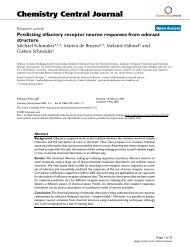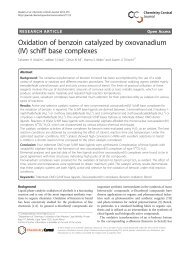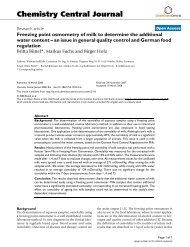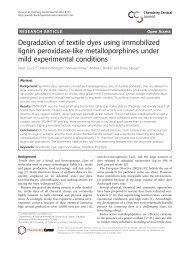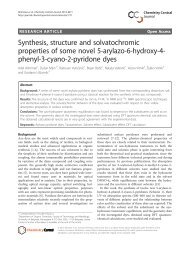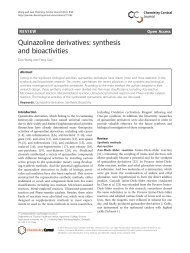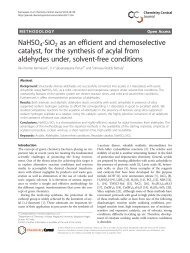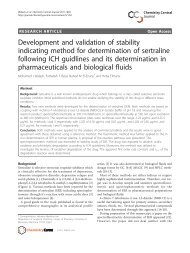New phosphine-diamine and phosphine-amino-alcohol tridentate ...
New phosphine-diamine and phosphine-amino-alcohol tridentate ...
New phosphine-diamine and phosphine-amino-alcohol tridentate ...
Create successful ePaper yourself
Turn your PDF publications into a flip-book with our unique Google optimized e-Paper software.
Fuentes et al. Chemistry Central Journal 2012, 6:151<br />
http://journal.chemistrycentral.com/content/6/1/151<br />
PRELIMINARY COMMUNICATION<br />
Open Access<br />
<strong>New</strong> <strong>phosphine</strong>-<strong>diamine</strong> <strong>and</strong> <strong>phosphine</strong>-<strong>amino</strong><strong>alcohol</strong><br />
<strong>tridentate</strong> lig<strong>and</strong>s for ruthenium catalysed<br />
enantioselective hydrogenation of ketones <strong>and</strong> a<br />
concise lactone synthesis enabled by asymmetric<br />
reduction of cyano-ketones<br />
José A Fuentes, Scott D Phillips <strong>and</strong> Matthew L Clarke *<br />
Abstract<br />
Enantioselective hydrogenation of ketones is a key reaction in organic chemistry. In the past, we have attempted to<br />
deal with some unsolved challenges in this arena by introducing chiral <strong>tridentate</strong> <strong>phosphine</strong>-<strong>diamine</strong>/Ru catalysts.<br />
<strong>New</strong> catalysts <strong>and</strong> new applications are presented here, including the synthesis of <strong>phosphine</strong>-<strong>amino</strong>-<strong>alcohol</strong> P,N,OH<br />
lig<strong>and</strong>s derived from (R,S)-1-<strong>amino</strong>-2-indanol, (S,S)-1-<strong>amino</strong>-2-indanol <strong>and</strong> a new chiral P,N,N lig<strong>and</strong> derived from (R,<br />
R)-1,2-diphenylethylene<strong>diamine</strong>. Ruthenium pre-catalysts of type [RuCl 2 (L)(DMSO)] were isolated <strong>and</strong> then examined<br />
in the hydrogenation of ketones. While the new P,N,OH lig<strong>and</strong> based catalysts are poor, the new P,N,N system gives<br />
up to 98% e.e. on substrates that do not react at all with most catalysts. A preliminary attempt at realising a new<br />
delta lactone synthesis by organocatalytic Michael addition between acetophenone <strong>and</strong> acrylonitrile, followed by<br />
asymmetric hydrogenation of the nitrile functionalised ketone is challenging in part due to the Michael addition<br />
chemistry, but also since Noyori pressure hydrogenation catalysts gave massively reduced reactivity relative to their<br />
performance for other acetophenone derivatives. The Ru <strong>phosphine</strong>-<strong>diamine</strong> system allowed quantitative<br />
conversion <strong>and</strong> around 50% e.e. The product can be converted into a delta lactone by treatment with KOH with<br />
complete retention of enantiomeric excess. This approach potentially offers access to this class of chiral molecules<br />
in three steps from the extremely cheap building blocks acrylonitrile <strong>and</strong> methyl-ketones; we encourage researchers<br />
to improve on our efforts in this potentially useful but currently flawed process.<br />
Keywords: Hydrogenation, Homogeneous catalysis, Keto-nitriles, P,N,O lig<strong>and</strong>s, P,N,N lig<strong>and</strong>s, Asymmetric synthesis,<br />
Chiral <strong>alcohol</strong>s, Organocatalysis, Michael addition, Acrylonitrile<br />
Findings<br />
Reduction of C = O <strong>and</strong> C = N double bonds using molecular<br />
hydrogen is a very important process, due to its<br />
low cost <strong>and</strong> complete atom efficiency [1]. Homogeneous<br />
hydrogenation of unfunctionalised ketones could<br />
not be carried out with sufficient efficiency or chemoselectivity<br />
until the Noyori group’s pioneering research<br />
on ruthenium complexes containing both di<strong>phosphine</strong><br />
<strong>and</strong> <strong>diamine</strong> lig<strong>and</strong>s (e.g. 1 <strong>and</strong> 2, Scheme 1) [2,3]. These<br />
catalysts give excellent results in the hydrogenation of a<br />
* Correspondence: mc28@st-<strong>and</strong>rews.ac.uk<br />
School of Chemistry, University of St Andrews, EaStCHEM, St Andrews, Fife<br />
KY16 9ST, UK<br />
range of acetophenone derivatives, as have a number of<br />
structurally related catalysts [4,5]. However, [RuCl 2<br />
(BINAP)(DAIPEN)] <strong>and</strong> related catalysts do have some<br />
important limitations, that have spurred significant interest<br />
in new catalyst development [6-21]. Given that so<br />
many drugs, agrochemicals, materials, <strong>and</strong> natural products<br />
can be disconnected back to enantiopure secondary<br />
<strong>alcohol</strong>s, it is of significant importance to extend asymmetric<br />
hydrogenation chemistry such that it is effective for<br />
every major class of substrate. We have already reported<br />
on the reduction of some of these challenging substrates,<br />
namely bulky ketones [6,10,11], heterocycle appended<br />
(bulky) ketones [10], <strong>and</strong> certain esters [9]. To achieve<br />
© 2012 Fuentes et al.; licensee Chemistry Central Ltd. This is an Open Access article distributed under the terms of the<br />
Creative Commons Attribution License (http://creativecommons.org/licenses/by/2.0), which permits unrestricted use,<br />
distribution, <strong>and</strong> reproduction in any medium, provided the original work is properly cited.
Fuentes et al. Chemistry Central Journal 2012, 6:151 Page 2 of 6<br />
http://journal.chemistrycentral.com/content/6/1/151<br />
Xyl 2<br />
H 2 Ar<br />
Cl<br />
P<br />
N<br />
P Ru Ar<br />
Cl N<br />
H2<br />
Pr i<br />
Xyl 2<br />
[RuCl 2 (Xyl-BINAP)(DAIPEN)]<br />
1<br />
Cl<br />
NH PPh 2<br />
Ru O<br />
N S<br />
H 2 Cl<br />
3<br />
Scheme 1 Hydrogenation catalysts.<br />
Xyl 2<br />
H 2<br />
Cl<br />
P<br />
N<br />
P Ru<br />
Cl N<br />
Xyl H2 2<br />
Cl<br />
NH PPh 2<br />
Ru O<br />
O<br />
H Cl<br />
S<br />
this, we developed ruthenium complexes of chiral <strong>tridentate</strong><br />
P,N,N <strong>and</strong> P,N,OH lig<strong>and</strong>s (derived from cyclohexane<br />
<strong>diamine</strong> <strong>and</strong> <strong>amino</strong>cyclohexanol). These gave moderate to<br />
excellent enantioselectivity <strong>and</strong> high yields where there<br />
was a precedent for [RuCl 2 (BINAP)(DAIPEN)] giving very<br />
low yields. However, while these results are significant in<br />
developing P,N,N lig<strong>and</strong>s for catalytic hydrogenation reactions,<br />
further improvements are needed for the catalysts<br />
to become industrially useful. In this paper, we report<br />
investigations into some alternative chiral backbones along<br />
with our initial attempt to apply these in a potentially concise<br />
asymmetric synthesis of delta lactones.<br />
The original catalyst design presumed the primary amine<br />
terminus of the catalyst would bind ketones <strong>and</strong> activate<br />
hydrogen in the same manner as Noyori catalysts. However,<br />
our recent mechanistic studies showed that the secondary<br />
amine of catalyst 3 is influential in both the<br />
efficient activation of hydrogen, <strong>and</strong> (most likely) the control<br />
of selectivity in asymmetric hydrogenation [12]. Since<br />
2<br />
4<br />
Ph<br />
Ph<br />
[RuCl 2 ((S)-BINAP)((S,S)-DPEN)]<br />
theprimaryamineterminusincomplex3 seemed less important,<br />
we have reported a single example of a P,N,O<br />
lig<strong>and</strong> <strong>and</strong> its Ru complex, 4 that gave good results in<br />
the enantioselective hydrogenation of ketones [12] <strong>and</strong><br />
good activity in the hydrogenation of aromatic esters<br />
[9]. An important extension was to investigate a different<br />
chiral backbone that had a strong heritage in asymmetric<br />
catalysis, 1-<strong>amino</strong>-2-indanol.<br />
Both diastereomers of the <strong>phosphine</strong>-<strong>amino</strong>-<strong>alcohol</strong><br />
lig<strong>and</strong>s 5 <strong>and</strong> 6 were readily prepared by condensation with<br />
diphenylphosphino-benzaldehyde followed by reduction<br />
with NaBH 4 with unoptimised yields of 75-97%. Reaction<br />
of <strong>phosphine</strong>-<strong>amino</strong>-<strong>alcohol</strong> lig<strong>and</strong>s with [RuCl 2 (DMSO) 4 ]<br />
gave, after purification, the diastereomeric complexes of<br />
formula [RuCl 2 (PNOH)(DMSO)], 5 <strong>and</strong> 6 in unoptimised<br />
yields of 67-78% (Scheme 2).<br />
With the new P,N,OH lig<strong>and</strong>s in h<strong>and</strong>, we turned our<br />
attention to a new P,N,N system. There are of course<br />
many <strong>diamine</strong>s known in the literature that might be<br />
used to make new derivatives of these catalysts. It was<br />
envisaged that through modification of the <strong>diamine</strong><br />
component, the orientation of the mechanistically important<br />
N-H bond could be optimised to maximise<br />
catalyst activity <strong>and</strong> selectivity. Our previous research<br />
pointed towards <strong>tridentate</strong> lig<strong>and</strong>s with relatively small<br />
N-N angles being most suitable <strong>and</strong> this prompted us to<br />
focus on a (R,R)-(+)-1,2-diphenylethylene<strong>diamine</strong> derived<br />
lig<strong>and</strong>. It is worth noting that the synthesis of lig<strong>and</strong>s with<br />
a primary amine terminus often proves more difficult than<br />
the <strong>phosphine</strong>-<strong>amino</strong>-<strong>alcohol</strong> systems, or for that matter,<br />
most <strong>phosphine</strong> lig<strong>and</strong>s. The synthesis of the ‘DPEN’-<br />
derived lig<strong>and</strong> threw up several synthetic difficulties preventing<br />
the isolation of pure lig<strong>and</strong>, but the crude lig<strong>and</strong><br />
was converted into its Ru complex that was then purified<br />
using column chromatography <strong>and</strong> fully characterised<br />
(Scheme 3). This could then be compared with the parent<br />
catalyst 3. On one occasion, this gave a 62% yield of complex<br />
8, with no purification of the crude lig<strong>and</strong>, but a<br />
PPh 2<br />
CHO<br />
(i) EtOH<br />
(ii) NaBH 4 , EtOH<br />
Ph 2 P<br />
[RuCl<br />
NH<br />
2 (DMSO) 4 ]<br />
THF, wave, 120 o C<br />
20 min.<br />
OH<br />
Cl<br />
HN<br />
Ru<br />
HO<br />
Cl<br />
PPh 2<br />
O<br />
S<br />
NH 2<br />
OH<br />
(1S,2R), (1S,2S) & (1R,2S) isomers<br />
H<br />
N Cl<br />
O<br />
H<br />
Ru<br />
Cl<br />
PPh 2<br />
O<br />
S<br />
H<br />
N Cl<br />
O<br />
H<br />
Ru<br />
Cl<br />
PPh 2<br />
O<br />
S<br />
5: (1S, 2R):<br />
ent-5: (1R, 2S) enantiomer<br />
6: (1S, 2S)<br />
Scheme 2 Synthesis of P,N,OH lig<strong>and</strong>s <strong>and</strong> their Ru(II) complexes.
Fuentes et al. Chemistry Central Journal 2012, 6:151 Page 3 of 6<br />
http://journal.chemistrycentral.com/content/6/1/151<br />
PPh 2<br />
CHO<br />
Ph<br />
Ph<br />
(i)<br />
NH 2 Ph<br />
NH 2<br />
Ph<br />
NH PPh 2 (ii)<br />
NH 2<br />
(R,R)-7<br />
(~40% purity)<br />
more reproducible method to generate pure material was<br />
to semi-purify the lig<strong>and</strong> using column chromatography<br />
although this gave lower yields. In any case, our objective<br />
was to test a pure catalyst of this type <strong>and</strong> this route was<br />
sufficient to achieve that.<br />
Asymmetric hydrogenation of ketones, 9a-12a (Scheme 4)<br />
was attempted using 5, ent-5 <strong>and</strong> 6 as the catalyst.<br />
Modest enantioselectivities were obtained in the hydrogenation<br />
of the easy substrate acetophenone, 9a<br />
(Table 1, Entries 1–5). In contrast to the P,N,N systems,<br />
enantioselectivity improves as base/Ru is increased up<br />
to 10:1, although even in the best scenarios, only 51% e.e.<br />
for <strong>alcohol</strong> 9b could be realised. The catalyst did not have<br />
enough activity to reduce the poorly reactive ketone, 10a<br />
(Table 1, Entry 7). For comparison, some results using previously<br />
reported catalyst 4 are given. These show the<br />
hugely enhanced reactivity <strong>and</strong> selectivity with the bulky<br />
ketone 10a using catalyst 4, but we also highlight an issue<br />
of maintaining enantioselectivity when reducing catalyst<br />
loadings below 0.1%.<br />
Table 2 reports the results for a small section of substrates<br />
that were hydrogenated with catalyst 8.<br />
Catalyst 8 was found to hydrogenate ketones quantitatively<br />
after 16 hours at 50°C <strong>and</strong> 50 bar hydrogen pressure<br />
(Table 3). Phenethyl <strong>alcohol</strong> was produced as<br />
practically racemic material as is generally the case with<br />
catalyst 3. The pressure hydrogenation of ketones with<br />
two alkyl carbons adjacent to the carbonyl has never<br />
given good results using any catalyst, so substrate 11a<br />
was attempted as a model for this, but no selectivity was<br />
observed. Reduction of α,α-dimethylpropiophenone 10a<br />
gave <strong>alcohol</strong> product in slightly increased enantioselectivity<br />
(80% e.e. Table 2, Entry 2) relative to catalyst 3.<br />
Reactions run at lower catalyst loading <strong>and</strong> shorter times<br />
reveal that, for this substrate, the activity is similar for<br />
both 3 <strong>and</strong> 8. The reduced selectivity below S/C =200 is<br />
also a drawback sometimes observed with catalyst 3; this<br />
behaviour will most likely preclude large scale applications<br />
in asymmetric catalysis until a solution is found.<br />
Ketone 12a, deactivated by two bulky substituents <strong>and</strong> a<br />
Ph<br />
Ph<br />
NH Cl<br />
PPh 2<br />
Ru<br />
N<br />
H 2 Cl<br />
O<br />
S<br />
(R,R)-8<br />
(analytically pure)<br />
Scheme 3 Synthesis of DPEN-derived catalyst (R,R)-8. General<br />
conditions: (i) (R,R)-(+)-1,2-diphenylethylene<strong>diamine</strong> (3 eq.), EtOH,<br />
45°C → rt, 2 h; NaBH 4 (4 eq.), EtOH, rt, 8 h; (ii) (R,R)-7 (1 eq.), [RuCl 2<br />
(DMSO) 4 ] (1 eq.), THF, μw, 120°C, 20 min.<br />
O Ru catalyst<br />
R 1 R 2 KOBu t co-catalyst, IPA, H 2<br />
O<br />
Ph Me<br />
9a<br />
O<br />
Ph Bu t<br />
10a<br />
O<br />
Ph<br />
11a<br />
O<br />
Me<br />
12a<br />
O<br />
O<br />
heterocycle gives a chiral diol, with potential as a chiral<br />
lig<strong>and</strong>, or as a precursor to chiral lig<strong>and</strong>s. Hydrogenation<br />
of 12a with either catalyst 3 or 8 furnished the diol<br />
product in almost complete enantiopurity (the e.e. is<br />
amplified compared to that expected for the hydrogenation<br />
of a single carbonyl bond due the Horeau effect,<br />
whereby the formation of meso compound allows for the<br />
‘removal’ of the undesired enantiomer [22]. This initial<br />
screen was sufficient to confirm that 8 is a competent alternative<br />
to catalyst 3, although so far with no advantages,<br />
especially given its difficult synthesis.<br />
A particular interest in our research group is seeking<br />
to use catalytic methods to promote the synthesis of<br />
high-value-added functionalised molecules from bulk<br />
<strong>and</strong> commodity chemicals with maximum atom-efficiency.<br />
With this concept in mind, a rather narrow range<br />
of reaction types can be used to keep to these principles<br />
[23,24], but Michael addition <strong>and</strong> hydrogenation fit this<br />
criteria. A general synthesis of enantiomerically enriched<br />
delta-lactones might be possible from the bulk chemical<br />
acrylonitrile <strong>and</strong> methyl ketones as shown in Scheme 5.<br />
δ-lactones represent an important class of natural products<br />
with interesting applications in the flavour <strong>and</strong> fragrance<br />
industry in particular [25]. Their synthesis is<br />
generally quite labour intensive, although lactone 15 has<br />
previously been made by CBS reduction of a hydroxyester<br />
<strong>and</strong> ester hydrolysis-lactonisation [26]. Two of the<br />
key steps in our very concise synthesis represent quite<br />
underdeveloped chemistry. As far back as 1955, the<br />
organocatalytic Michael addition to acrylonitrile was<br />
reported in a patent [27], but no modern examples of<br />
organocatalytic acrylonitrile Michael additions exist. In<br />
Ph<br />
HO<br />
O<br />
OH<br />
R 1 R 2<br />
OH<br />
Ph Me<br />
9b<br />
OH<br />
Ph Bu t<br />
10b<br />
11b<br />
12b<br />
OH<br />
Me<br />
OH<br />
Scheme 4 Substrates <strong>and</strong> products of hydrogenation reaction<br />
reported in Tables 1 <strong>and</strong> 2.
Fuentes et al. Chemistry Central Journal 2012, 6:151 Page 4 of 6<br />
http://journal.chemistrycentral.com/content/6/1/151<br />
Table 1 Enantioselective hydrogenation of some ketones<br />
using Ru catalysts derived from <strong>phosphine</strong>-<strong>amino</strong><strong>alcohol</strong>s<br />
Entry [a] Cat Ketone [cat]<br />
mol%<br />
[base]<br />
mol%<br />
Conversion<br />
(yield) [%] [b]<br />
e.e.<br />
[%] [c]<br />
1 5 9a 0.5 1 99 23 (S)<br />
2 6 9a 0.5 1 99 27 (R)<br />
3 ent-5 9a 0.5 1 99 29 (R)<br />
4 ent-5 9a 0.5 2.5 99 43 (R)<br />
5 ent-5 9a 0.5 5 98 51 (R)<br />
6 4 9a 0.5 2.5 99 (99) 15 (S)<br />
7 5 10a 0.5 1 26 4<br />
8 4 10a 0.5 2.5 99 (99) 74 (S)<br />
9 [d] 4 10a 0.5 2.5 99 79 (S)<br />
10 [e] 4 10a 1 5 98 80 (S)<br />
11 4 10a 0.09 5 45 3 (S)<br />
12 6 11a 0.5 2.5 99 (97) 0<br />
[a] Unless otherwise indicated, reactions were carried out using 0.33 mmol mL -1<br />
of ketone at 50°C <strong>and</strong> 50 bar of hydrogen pressure with a 16 h reaction time<br />
using t-BuOK as base. [b] Conversions were determined by 1 H NMR analysis of<br />
the crude reaction mixtures (all peaks were assigned). Yields are for pure<br />
<strong>alcohol</strong>s after short-path silica gel chromatography. [c] The e.e. value was<br />
determined by chiral HPLC. [d] 35°C. [e] 3h.<br />
our h<strong>and</strong>s, this reaction only gave 30% yield of the<br />
desired ketone (<strong>and</strong> a brief screen of some other primary<br />
<strong>and</strong> secondary amines did not improve this).<br />
Whilst this substrate can be accessed by other routes in<br />
higher yield (see Additional file 1 <strong>and</strong> ref [28]), the<br />
organocatalytic Michael addition approach is worthy of<br />
a further research study given its atom-efficiency, its<br />
use of very simple, cheap reagents <strong>and</strong> the potential<br />
utility of the products. To the best of our knowledge,<br />
the asymmetric hydrogenation of nitrile-functionalised<br />
ketones does not appear in any of the plethora of<br />
Table 2 Enantioselective hydrogenation of some ketones<br />
using catalyst 8<br />
Entry a Ketone Catalyst Time (h) Conversion [%] b e.e. [%] c<br />
1 9a (R,R)-8 (0.5%) 16 >99 3<br />
2 10a (R,R)-8 (0.5%) 16 >99 80 (S)<br />
3 10a (R,R)-3 (0.5%) 16 >99 74 (S)<br />
4 10a (R,R)-8 (0.33%) 1 44 56 (S)<br />
5 10a (S,S)-3 (0.33%) 1 45 65 (R)<br />
6 11a (R,R)-8 16 >99 9<br />
7 12a (R,R)-8 16 >99 98 d<br />
8 e 12a (R,R)-3 16 >99 98 f<br />
a Reactions were carried out using 0.33 mmol mL -1 of ketone, 0.5 mol%<br />
preformed catalyst (R,R)-27 <strong>and</strong> 1 mol% KO t Bu at 70°C <strong>and</strong> 50 bar of hydrogen<br />
pressure with a 16 h reaction time. b Conversions were determined by 1 H NMR<br />
analysis of the crude reaction mixtures (all peaks assigned). c The e.e. value<br />
was determined by chiral HPLC (Chiralpak AD-H/Chiralcel OD-H column). The<br />
absolute configuration was determined to be S by comparison of optical<br />
rotation values with literature values. d ((R,R) +(S,S)):meso 3.1:1. e Reaction<br />
temperature of 50°C. f {(R,R) +(S,S)}:meso 2.8:1.<br />
Table 3 Enantioselective hydrogenation of ketone 13<br />
Entry a Catalyst Temp. (°C) Conversion (%) b e.e. (%) c<br />
1 2 70 21 d 56<br />
2 3 70 >99 49<br />
3 8 70 37 50<br />
4 3 50 14 54<br />
5 4 70 99% yield, 74% e.e.). (v) KOH (5 eq.),<br />
ethylene glycol, reflux, 24 h, then 10% HCl (76% yield, 74% e.e).<br />
17<br />
(v)<br />
Ph<br />
O<br />
O<br />
18<br />
O<br />
15<br />
O
Fuentes et al. Chemistry Central Journal 2012, 6:151 Page 5 of 6<br />
http://journal.chemistrycentral.com/content/6/1/151<br />
<strong>and</strong> Table 3, this type of substrate seems to inhibit typical<br />
hydrogenation catalysts.<br />
The asymmetric hydrogenation of the keto-nitrile 13<br />
was studied using conditions that will readily reduce simple<br />
acetophenones. We found that the Noyori catalyst, 2<br />
only gave a 21% conversion to product at 70°C with 56%<br />
e.e. (Table 3, Entry 1). On the other h<strong>and</strong>, catalyst 3 gave<br />
quantitative conversion to the desired <strong>alcohol</strong>, with<br />
complete chemoselectivity <strong>and</strong> a moderate 49% e.e.<br />
(Table 3, Entry 2). Lowering the temperature or switching<br />
to catalyst 8 resulted in lower conversion <strong>and</strong> no significant<br />
increases in enantioselectivity (Table 3, Entries 3–5).<br />
The P,N,OH catalyst, 4 was inactive. It is clear that the<br />
nitrile-ketones are extremely challenging substrates, although<br />
the St Andrews catalysts show distinct promise for<br />
this little studied but potentially useful class of ketone<br />
hydrogenations. We firmly encourage other researchers to<br />
improve on our efforts. The chiral <strong>alcohol</strong> produced was<br />
treated with KOH at high temperature resulting in formation<br />
of the lactone 15 in 62% yield. HPLC analysis <strong>and</strong><br />
comparison of optical rotation data shows that this occurred<br />
with complete retention of stereochemistry. We<br />
briefly examined a gem-dimethyl analogue of 13 using<br />
catalyst 3 <strong>and</strong> were pleased to find it gave quantitative<br />
conversion <strong>and</strong> 74% e.e. for the product 17, <strong>and</strong> that this<br />
could also be converted into lactone 18 with complete retention<br />
of stereochemistry.<br />
Conclusions<br />
The important objective of comparing a different<br />
<strong>phosphine</strong>-<strong>amino</strong>-<strong>alcohol</strong> lig<strong>and</strong> to catalyst 4 has been<br />
accomplished, although this has ultimately delivered<br />
poor catalysts. The (R,R)-1,2-diphenylethylene<strong>diamine</strong><br />
derived catalyst, while not offering large advantages over<br />
the previous systems developed in our laboratory is quite<br />
an effective catalyst that we now use in catalyst screening<br />
for more application-orientated studies. An example<br />
of a rather unique, but not yet viable, application of<br />
these catalysts is the delta lactone synthesis described;<br />
this potentially offers access to this class of molecules in<br />
three steps from the extremely cheap building blocks<br />
acrylonitrile <strong>and</strong> methyl-ketones. Both the organocatalytic<br />
acrylonitrile Michael addition <strong>and</strong> the asymmetric hydrogenation<br />
of nitrile-functionalised ketones are interesting<br />
unresolved target applications to spur the evaluation of<br />
new catalysts.<br />
Additional file<br />
Addition file 1: Full experimental details are available in Additional<br />
file 1.<br />
Competing interests<br />
The authors declare they have no competing interests.<br />
Authors’ contributions<br />
MC conceived of the projects described herein, assisted with experimental<br />
design <strong>and</strong> wrote the paper. SP carried out most of the ‘DPEN’ catalyst<br />
studies <strong>and</strong> the lactone synthesis. JF carried out the studies on the PNOH<br />
catalysts, prepared some substrates, contributed towards the synthetic<br />
studies on the DPEN catalyst <strong>and</strong> assisted in the writing of the paper. All<br />
authors read <strong>and</strong> approved the final manuscript.<br />
Authors’ information<br />
Matt Clarke leads a research group that is developing greener scaleable<br />
catalytic synthetic methods at the University of St Andrews, EaStCHEM. The<br />
group works closely with industry. While the results of the groups work have<br />
been published in around 65 recent articles in the leading international<br />
chemistry journals, the authors are keen supporters of open-access journals<br />
that offer either free publication <strong>and</strong> access, or an institutional membership.<br />
Dr Scott Phillips completed his PhD in the Clarke group in 2011, specialising<br />
in asymmetric hydrogenation using Ru complexes of <strong>tridentate</strong> lig<strong>and</strong>s. Dr<br />
José Fuentes completed his PhD in 2004 <strong>and</strong> is a post-doctoral research<br />
fellow <strong>and</strong> honorary lecturer in the Clarke group who is currently involved in<br />
several projects ranging from using supramolecular co-catalysts to optimise<br />
homogeneous catalytic reactions, the simultaneous control of regioselectivity<br />
<strong>and</strong> enantioselectivity in various alkene carbonylations <strong>and</strong> asymmetric<br />
hydrogenation reactions.<br />
Acknowledgements<br />
The authors thank all the technical staff at the University of St Andrews<br />
School of Chemistry for their efforts. This research was funded by the EPSRC.<br />
Received: 6 November 2012 Accepted: 4 December 2012<br />
Published: 10 December 2012<br />
References<br />
1. De Vries JG, Elsevier CJ: H<strong>and</strong>book of homogeneous hydrogenation.<br />
Wiley VCH: Weinheim; 2007.<br />
2. Noyori R, Ohkuma T: Asymmetric catalysis by architectural <strong>and</strong> functional<br />
molecular engineering: practical chemo- <strong>and</strong> stereoselective<br />
hydrogenation of ketones. Angew Chem Int Ed 2001, 40:40–73.<br />
3. Ohkuma T, Ooka H, Hashiguchi S, Ikariya T, Noyori R: Practical<br />
enantioselective hydrogenation of aromatic ketones. J Am Chem Soc<br />
1995, 117:2675–2676.<br />
4. Ohkuma T, S<strong>and</strong>oval CA, Srinivasan R, Lin Q, Wei Y, Muniz K, Noyori R:<br />
Asymmetric hydrogenation of tert-alkyl ketones. J Am Chem Soc 2005,<br />
127:8288–8289.<br />
5. Burk MJ, Hems W, Herzberg D, Malan C, Zanotti-Gerosa A: A catalyst for<br />
efficient <strong>and</strong> highly enantioselective hydrogenation of aromatic,<br />
heteroaromatic, <strong>and</strong> alpha, beta-unsaturated ketones. Org Lett 2000,<br />
2:4173–4176.<br />
6. Clarke ML, Diaz-Valenzuela MB, Slawin AMZ: Hydrogenation of aldehydes,<br />
esters, imines, <strong>and</strong> ketones catalyzed by a ruthenium complex of a chiral<br />
<strong>tridentate</strong> lig<strong>and</strong>. Organometallics 2007, 26:16–19.<br />
7. Abdur-Rashid K, Guo RW, Lough AJ, Morris RH, Song DT: Synthesis of<br />
ruthenium hydride complexes containing beta-<strong>amino</strong><strong>phosphine</strong> lig<strong>and</strong>s<br />
derived from <strong>amino</strong> acids <strong>and</strong> their use in the H2-hydrogenation of<br />
ketones <strong>and</strong> imines. Adv Synth Catal 2005, 347:571–579.<br />
8. Baratta W, Ballico M, Chelucci G, Siega K, Rigo P: Osmium(II) CNN pincer<br />
complexes as efficient catalysts for both asymmetric transfer <strong>and</strong> H(2)<br />
hydrogenation of ketones. Angew Chem Int Ed 2008, 47:4362–4365.<br />
9. Carpenter I, Eckelmann SC, Kuntz MT, Fuentes JA, France MB, Clarke ML:<br />
Convenient <strong>and</strong> improved protocols for the hydrogenation of esters<br />
using Ru catalysts derived from (P,P), (P,N,N) <strong>and</strong> (P,N,O) lig<strong>and</strong>s. Dalton<br />
Trans 2012, 41:10136–10140.<br />
10. Diaz-Valenzuela MB, Phillips SD, France MB, Gunn ME, Clarke ML:<br />
Enantioselective hydrogenation <strong>and</strong> transfer hydrogenation of bulky<br />
ketones catalysed by a ruthenium complex of a chiral <strong>tridentate</strong> lig<strong>and</strong>.<br />
Chem-Eur J 2009, 15:1227–1232.<br />
11. Phillips SD, Andersson KHO, Kann N, Kuntz MT, France MB, Wawrzyniak P,<br />
Clarke ML: Exploring the role of phosphorus substituents on the<br />
enantioselectivity of Ru-catalysed ketone hydrogenation using <strong>tridentate</strong><br />
<strong>phosphine</strong>-<strong>diamine</strong> lig<strong>and</strong>s. Catal Sci Technol 2011, 1:1336–1339.<br />
12. Phillips SD, Fuentes JA, Clarke ML: On the NH effect in rutheniumcatalysed<br />
hydrogenation of ketones: Rational design of <strong>phosphine</strong>-
Fuentes et al. Chemistry Central Journal 2012, 6:151 Page 6 of 6<br />
http://journal.chemistrycentral.com/content/6/1/151<br />
<strong>amino</strong>-<strong>alcohol</strong> lig<strong>and</strong>s for asymmetric hydrogenation of ketones.<br />
Chem-Eur J 2010, 16:8002–8005.<br />
13. Ito J, Ujiie S, Nishiyama H: <strong>New</strong> bis(oxazolinyl)phenyl-ruthenium(II)<br />
complexes <strong>and</strong> their catalytic activity for enantioselective hydrogenation<br />
<strong>and</strong> transfer hydrogenation of ketones. Organometallics 2009, 28:630–638.<br />
14. Ito M, Endo Y, Ikariya T: Well-defined triflylamide-tethered arene-ru<br />
(tsdpen) complexes for catalytic asymmetric hydrogenation of ketones.<br />
Organometallics 2008, 27:6053–6055.<br />
15. Jolley KE, Zanotti-Gerosa A, Hancock F, Dyke A, Grainger DM, Medlock JA,<br />
Nedden HG, Le Paih JJM, Roseblade SJ, Seger A, Sivakumar V, Prokes I,<br />
Morris DJ, Wills M: Application of tethered ruthenium catalysts to<br />
asymmetric hydrogenation of ketones, <strong>and</strong> the selective hydrogenation<br />
of aldehydes. Adv Synth Catal 2012, 354:2545–2555.<br />
16. Naud F, Malan C, Spindler F, Ruggeberg C, Schmidt AT, Blaser HU: Ru-<br />
(<strong>phosphine</strong>-oxazoline) complexes as effective, industrially viable<br />
catalysts for the enantioselective hydrogenation of aryl ketones.<br />
Adv Synth Catal 2006, 348:47–50.<br />
17. WWN O, Lough AJ, Morris RH: The hydrogenation of molecules with polar<br />
bonds catalyzed by a ruthenium(II) complex bearing a chelating N-<br />
heterocyclic carbene with a primary amine donor. Chem Commun 2010,<br />
46:8240–8242.<br />
18. Touge T, Hakamata T, Nara H, Kobayashi T, Sayo N, Saito T, Kayaki Y, Ikariya<br />
T: Oxo-tethered ruthenium(II) complex as a bifunctional catalyst for<br />
asymmetric transfer hydrogenation <strong>and</strong> (H2) hydrogenation. J Am Chem<br />
Soc 2011, 133:14960–14963.<br />
19. Ohkuma T, Utsumi N, Tsutsumi K, Murata K, S<strong>and</strong>oval C, Noyori R:<br />
The hydrogenation/transfer hydrogenation network: asymmetric<br />
hydrogenation of ketones with chiral η6-arene/N-tosylethylene<strong>diamine</strong> −<br />
ruthenium(II) catalysts. JAmChemSoc2006, 128:8724–8725.<br />
20. Wang C, Villa-Marcos B, Xiao JL: Hydrogenation of imino bonds with halfs<strong>and</strong>wich<br />
metal catalysts. Chem Commun 2011, 47:9773–9785.<br />
21. Xu YJ, Alcock NW, Clarkson GJ, Docherty G, Woodward G, Wills M:<br />
Asymmetric hydrogenation of ketones using a ruthenium(II) catalyst<br />
containing binol-derived monodonor phosphorus-donor lig<strong>and</strong>s. Org Lett<br />
2004, 6:4105–4107.<br />
22. Vigneron JP, Dhaehens M, Horeau A: Nouvelle methode pur porter au<br />
maximum la purete optique d’un produit partiellement dedouble sans<br />
l’aide d’aucune substance chirale. Tetrahedron 1973, 29:1055–1059.<br />
23. Clarke ML, Roff GJ: Highly regioselective rhodium catalysed<br />
hydroformylation of unsaturated esters: the first practical method for<br />
quaternary selective carbonylation. Chem-Eur J 2006, 12:7978–7986.<br />
24. Noonan GM, Cobley CJ, Lebl T, Clarke ML: Asymmetric hydroformylation<br />
of an enantiomerically pure bicyclic lactam; efficient synthesis of<br />
functionalised cyclopentylamines. Chem-Eur J 2010, 16:12788–12791.<br />
25. Sabitha G, Bhaskar V, Yadav JS: The first asymmetric total synthesis of<br />
(R)-tuberolactone, (S)-jasmine lactone <strong>and</strong> (R)-delta-decalactone.<br />
Tetrahedron Lett 2006, 47:8179–8181.<br />
26. Downham R, Edwards PJ, Entwistle DA, Hughes AB, Kim KS, Ley SV:<br />
Dispiroketals in synthesis 19. Dispiroketals as enantioselective <strong>and</strong><br />
regioselective protective agents for symmetrical cyclic <strong>and</strong> acyclic<br />
polyols. Tetrahedron-Asymm 1995, 6:2403–2440.<br />
27. Krimm H: Process for the production of α-monocyanoethyl ketones.<br />
US patent (Farbenfabrika Bayer Aktengesellshaft), US1958:2850519.<br />
28. Wessig P, Muehling O: Photochemical synthesis of highly functionalised<br />
cyclopropyl ketones. Helv chim Acta 2003, 86:865–885.<br />
29. Soltani O, Ariger MA, Henar VV, Carreira EM: Transfer Hydrogenation in<br />
water: enantioselective, catalytic reduction of alpha cyano <strong>and</strong> alpha<br />
nitro acetophenones. Org Lett 2010, 12:2893–2895.<br />
30. Enthaler S, Junge K, Addis D, Erre G, Beller M: A practical <strong>and</strong> benign<br />
synthesis of primary amine through ruthenium-catalysed reduction of<br />
nitriles. Chemsus Chem 2008, 1:1006–1010.<br />
doi:10.1186/1752-153X-6-151<br />
Cite this article as: Fuentes et al.: <strong>New</strong> <strong>phosphine</strong>-<strong>diamine</strong> <strong>and</strong><br />
<strong>phosphine</strong>-<strong>amino</strong>-<strong>alcohol</strong> <strong>tridentate</strong> lig<strong>and</strong>s for ruthenium catalysed<br />
enantioselective hydrogenation of ketones <strong>and</strong> a concise lactone<br />
synthesis enabled by asymmetric reduction of cyano-ketones. Chemistry<br />
Central Journal 2012 6:151.<br />
Publish with ChemistryCentral <strong>and</strong> every<br />
scientist can read your work free of charge<br />
Open access provides opportunities to our<br />
colleagues in other parts of the globe, by allowing<br />
anyone to view the content free of charge.<br />
W. Jeffery Hurst, The Hershey Company.<br />
available free of charge to the entire scientific community<br />
peer reviewed <strong>and</strong> published immediately upon acceptance<br />
cited in PubMed <strong>and</strong> archived on PubMed Central<br />
yours you keep the copyright<br />
Submit your manuscript here:<br />
http://www.chemistrycentral.com/manuscript/





